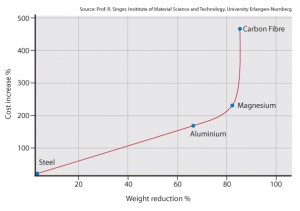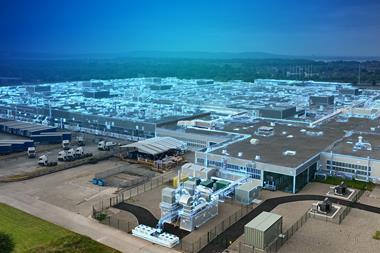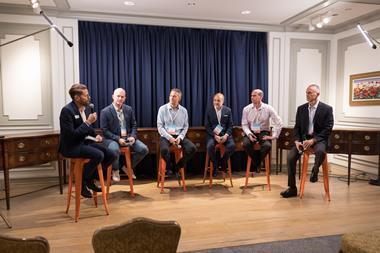
Dreistern’s roll-forming solutions are the key to cost savings and materials innovation, writes Heinrich Weber, sales director with Dreistern GmbH & Co. KG.
 As one of Germany’s leading producers of roll-forming equipment, Dreistern has developed some exciting solutions to the challenges facing manufacturers of roll-formed automotive parts. Key to Dreistern’s philosophy is the belief that innovation flows from understanding the need to target future customers with products that will appeal to them.
As one of Germany’s leading producers of roll-forming equipment, Dreistern has developed some exciting solutions to the challenges facing manufacturers of roll-formed automotive parts. Key to Dreistern’s philosophy is the belief that innovation flows from understanding the need to target future customers with products that will appeal to them.
Sometimes these products are made from innovative materials, but often they are the result of new manufacturing processes. Once a product is successful, it represents an extremely important competitive advantage.
Innovation flows from ideas, although an idea itself is not an innovation. An idea only becomes an innovation once it has been turned into a product that customers want to buy. So how do you innovate?
Global roll-forming trends
There are many brilliant innovations, although not all of them find a market because sometimes they are ahead of their time. Equally, there are those innovations that follow a trend, and these have much better chances of success. One example is the global move to regulate CO2 emissions. Here, developments in major automotive markets such as the USA, Europe, Korea, Japan and China are forcing the motor industry to meet demanding CO2 reduction targets.
In the short term, targets will, as a minimum, force the industry to secure weight savings and produce low-emission engines using existing technologies. But in the longer term, there will be an even greater need for industry to innovate both its products and its processes.
At the same time, manufacturers must hit stringent cost targets, especially for high-volume vehicles. Sophisticated materials such as high-strength aluminium alloys, magnesium or carbon fibre are extremely quick routes to weight savings, but they also carry a cost penalty.
A cheaper alternative is ultra-high strength steel giving a tensile strength beyond 1,000 MPa. Today, it is possible for steel suppliers to deliver steel grades that are purpose-designed for roll forming and which offer a tensile strength up to 1,700 MPa. And it is here that roll forming can offer substantial benefits.
Typically, stamped-metal parts made from high-strength steels are produced by hot forming, which carries a high process cost. Roll forming, however, can process ultra-high strength steels at ambient temperatures and deliver cost savings. Its material utilisation rate is closer to 100% than the 70% to 80% achieved in press manufacturing. This adds up to substantial cost savings.
Finally, roll-forming tool costs are considerably lower than those associated with press tooling. Many bumper-reinforcement beams, door-intrusion beams, rocker-panel inners and reinforcements, side-sill reinforcements or belt-line reinforcements in cars today are excellent examples of the weight and cost savings that can be achieved with roll forming.
It is worth noting that the doubling of sales achieved by some successful automotive brands in the past decade has only been possible thanks to disproportionate increases in the number of models on offer. This trend presents an ongoing challenge for manufacturers of production equipment. Generally speaking, a modern press shop must execute a tool change every two hours and complete it within minutes.
The same applies to roll-forming lines, which must supply parts just-in-sequence to automotive assembly lines. This is only possible with advanced tool-change technologies. The ability to deliver product-mix operation alongside weight and cost savings has made roll forming the production method of choice for many automotive parts.
Superior roll-formed rocker panels
The tolerances expected of many roll-formed parts across a variety of industries are rarely demanding. This is not the case, however, with automotive applications. Dispersed automated assembly operations require considerably narrower tolerance margins. And it is unfortunately the case that ultra-high strength steels (UHSS) can exhibit large fluctuations in material properties such as spring back, yield strength or flatness of the sheet metal strip. These can only be managed through special forming techniques.
Such techniques are essential to meeting international automotive quality standards. It took Dreistern more than 10 years spread across many endeavors in the USA, Europe, Korea, China and Japan to gain the depth of experience necessary to develop a new forming technology that could cope with the challenges of UHSS material. The end result, however, is a rocker panel that delivers not only superior quality but which also offers new tolerances in the range of ± 0.3mm and ± 0.5mm.

A coil change is a potential nightmare for any production manager, particularly if the material properties of the new coil are substantially different to the old one. Only where a roll-forming machine is equipped with a simple adjustment mechanism do production staff stand any chance of eliminating tolerance deviations quickly and with a small number of rejected parts.
It is to meet this challenge that Dreistern has developed highly reproducible devices that allow precise corrections to be made to each bending angle. This means that the large fluctuations in material properties that are a feature of ultra-high strength steels can be compensated for with ease.
Today´s rocker panel designs usually feature numerous holes, notches, embossing or side-cuts, and it is possible to integrate these operations into roll forming lines easily. In the past, however, comprehensive punching operations resulted in considerable increases in both tooling costs and the scale of the production line. It also slowed down production and tool changeover times for different products.
Now, however, Dreistern has introduced a new punching press that is designed especially for roll-forming lines. This pressing innovation can accommodate punching tools in a groundbreaking, cost-saving design. It can also be used for both the pre- and post-punching operations that are necessary with many types of rocker panels. In addition, tool changes can be speeded up substantially with high-speed tool-changing equipment. These developments can have a substantial impact on overall equipment efficiency (OEE) and mean that rocker panels produced on these lines can be produced at lower cost per part than was possible before.
Exciting bumper production technologies
The demand for variable and smaller sweep radii is another development that has followed on from modern car designs. Both were hitherto impossible to achieve without compromising on part tolerances. Small sweep radii cause waves or wrinkles and this meant that OEMs had to accept lower-quality parts in order to benefit from the cost and weight savings that come with roll-formed bumpers.
But Dreistern’s development of a new CNC roll-bending process that can be integrated into roll-forming lines has transformed this situation. This new process gives OEMs the benefits of variable radii and much smaller sweeps, while the perfectly formed, smooth surfaces of these new bumpers have surprised experts.
In principle, this technology is based on existing roll bending techniques. Nonetheless, it was Dreistern engineers who developed the vital auxiliary equipment that guides the roll-formed bumper from both the inside and outside. In addition, the technology allows parts producers to deliver the sort of bumper shapes that are guaranteed to please even the most creative of designers.
Enabling rapid product innovations
Today, the enormous pressure that global trends exert on automotive production has an obvious effect on both end products and related production processes. Accordingly, the ability to deliver enough of a new product, when it is needed, can be the key to a business’s survival. Equally, most of the production lines in existence today were set up to deliver a limited number of products. And these products were often developed long before the equipment that produces them had been installed.
Accordingly, a manufacturer who wants to produce a completely new product could be in for a nasty surprise, in the worst case scenario, that costly, time-consuming modifications can bring into question about the profitability of existing equipment. It was with this in mind that Dreistern developed a completely new generation of roll-forming equipment to transform the roll former into a highly flexible and universal sheet-metal processing centre. Dreistern calls this exciting new technology Multifunctional Rollforming.
The concept behind this new approach is simple and based around the idea of individual work modules that are designed as mobile units with standardised interfaces and an independent control system. This allows positioning at any point inside the roll former within a few minutes. The punching modules offer both flying and Start-Stop® operation to give improved tolerances at higher production speeds.
All of the work modules can be utilised at different machines. This is especially advantageous with costly work modules such as laser welding cells. And because laser welding can now be deployed on any roll-forming line, it becomes much more economical. Regardless of the production process required, this new roll former can be swiftly adapted to meet any requirement.
The first wave of Dreistern’s multifunctional roll formers has been in operation for several months now. The early feedback from users has been extremely positive.


































